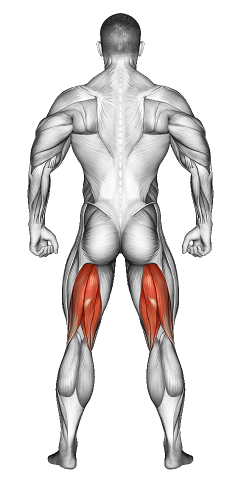Single Leg Exercise Ball Leg Curl: Video Tutorial & Exercise Guide

Written By: Claude Michael
Updated: Oct 13, 2024
| Workout | Single Leg Exercise Ball Leg Curl |
| Primary Muscle Group | Hamstrings |
| Equipment Required | Exercise Ball |
| Force Type | Pull |
| Mechanics | Isolation |
| Exercise Type | Strength |
| Difficulty | Intermediate |
Single Leg Exercise Ball Leg Curl: Video Tutorial & Exercise Guide
- 1.Single Leg Exercise Ball Leg Curl: Muscle Groups
- -1.1Primary Muscle Group
- -1.2Secondary Muscle Group
- 2.Single Leg Exercise Ball Leg Curl: Step-by-Step Guide
- 3.Single Leg Exercise Ball Leg Curl: Overview
- 4.Single Leg Exercise Ball Leg Curl: Benefits
- 5.Single Leg Exercise Ball Leg Curl: Pro Tips & Advanced Techniques
- 6.Single Leg Exercise Ball Leg Curl: Progression Plan
- 7.Single Leg Exercise Ball Leg Curl: Frequently Asked Questions (FAQs)
Single Leg Exercise Ball Leg Curl: Step-by-Step Guide
- Step 1: Lie flat on your back with your arms by your sides and place one foot on top of an exercise ball. Keep the other leg extended straight toward the ceiling.
- Step 2: Engage your core and glutes as you lift your hips off the floor, forming a straight line from your shoulders to your knees.
- Step 3: Keeping your hips lifted, bend the knee of the leg that’s on the ball, rolling the ball toward your glutes by curling your hamstring.
- Step 4: Extend your leg back to the starting position by straightening your knee while keeping your hips elevated.
- Step 5: Lower your hips down to the ground after completing the desired number of reps, then switch legs and repeat on the other side.
Single Leg Exercise Ball Leg Curl: Overview
The single leg exercise ball leg curl is a fantastic move that isolates the hamstrings while also engaging the glutes, core, and stabilizing muscles. This exercise adds instability with the use of an exercise ball, making it more challenging than traditional leg curls and providing extra benefits for balance and coordination.
Single Leg Exercise Ball Leg Curls: Benefits
This exercise is excellent for building hamstring strength, improving core stability, and enhancing hip mobility. The single-leg variation forces you to focus on one leg at a time, helping correct muscle imbalances. It also challenges your balance and engages your stabilizer muscles, particularly in the glutes and core.
Single Leg Exercise Ball Leg Curl: Pro Tips & Advanced Techniques
Form focus: Keep your hips elevated throughout the entire movement to maintain tension in your hamstrings and glutes. Avoid letting your hips sag as you curl the ball.
Slow and controlled: Perform the movement slowly to maximize engagement and control. Don’t rush through the reps—focus on squeezing your hamstrings at the top of the movement.
Added challenge: For a more advanced variation, hold the top position for a couple of seconds after curling the ball toward your glutes to really engage the hamstrings.
Single Leg Exercise Ball Leg Curls: Progression Plan
Beginner
Intermediate
Advanced
Single Leg Exercise Ball Leg Curl: Frequently Asked Questions (FAQs)
What muscles do single leg exercise ball leg curls target?
+They primarily target the hamstrings but also engage the glutes, core, and calves for stability and control.
Can I do this exercise without an exercise ball?
+While the ball adds instability, you can perform a similar movement with sliders or towels on a smooth surface. However, using the ball provides more challenge and balance benefits.
How often should I do single leg exercise ball leg curls?
+Incorporate this exercise into your lower body workouts 1-2 times a week to improve hamstring strength and core stability.
What are common mistakes to avoid?
+Avoid letting your hips drop during the movement. Focus on keeping your body in a straight line from shoulders to knees throughout the exercise.
Share
Don’t Wish for It, Work for It – Join the FlexXP Newsletter Today!
Thank you for signing up for the FlexXP Newsletter!
This site is protected and the Google Privacy Policy and Terms of Service apply.
